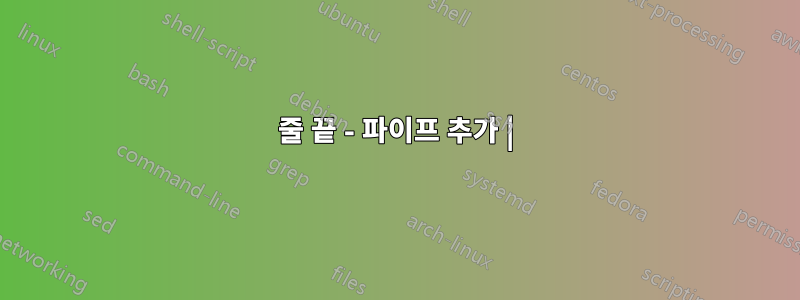
각 줄 끝에 정규식을 사용하여 파이프를 배치하는 방법을 설명할 수 있는 사람이 있습니까?
메모장에서 찾기 및 바꾸기 사용 ++
배치하려고 해요content |
건배!
답변1
각 줄의 끝에 파이프를 추가하려면 다음 '찾기' 정규식을 사용하세요.
$
(달러 기호는 정규식의 줄 끝과 일치합니다)
그리고 이 '교체'는 다음과 같습니다.
|
정규식 찾기를 활성화했는지 확인하세요.
답변2
무엇을 찾다:(.*)
다음으로 교체:$1|
이는 다음을 사용합니다.그룹화, $1기본적으로 괄호 안에 있는 내용을 삽입한 다음 파이프를 끝에 추가하라는 의미입니다. .이 상황에 이상적인 줄 바꿈과 같은 특정 공백을 제외한 모든 문자를 캡처합니다 . 이 *방법을 사용하면 0개 이상의 문자를 캡처할 수 있습니다..
이는 확장 가능하므로 특정 라인(예: test가 포함된 라인)만 캡처하려는 경우:
무엇을 찾다:(.*test.*)
다음으로 교체:$1|
따라서 이를 입력하고 "모두 바꾸기"를 누르면 정규식과 일치하는 각 줄 끝에 파이프가 표시됩니다.
답변3
답변이 변경되었습니다.
나는 이것을 사용할 것이다. 나는 단일 또는 다중 라인 모드에서 작업합니다.
어떤 메모장을 사용할 수 있는지 잘 모르겠습니다(예: 검색/바꾸기, 찾기/바꾸기 등).
다음을 찾아 (?=\r\n|\n|\r|$)
다음을 삽입(바꾸기)하세요. |
$ Metachar가 실제로 무엇인지에 대한 복잡한 주제에 대한 몇 가지 참고 사항입니다.
생각만큼 쉽지는 않으며 문서에는 부족한 부분이 많습니다.
어쨌든 여기에 내 의견이 있습니다 -
# Regular Expression Docs:
# Metacharacter $
# Match the end of the line (or before newline at the end)
# ** This really is misworded, it really means:
#
# In single line mode,
# In two separate matches (in global context)
# Match before and after a newline at the end of a string if there is a newline,
# OR, Match the end of the string only.
#
# In multi-line mode,
# Match before OR after a newline at the end of a line or string,
# but not both.
#
# ---------------------------------------------
# The above explanation is conditional upon the qualifying
# subexpressions surrounding the $ metachar
# ---------------------------------------------
# /$/g Single line mode:
# Matches before newline (if there is one) AND end of string (always this)
print "=== /\$/g ===============\n";
$str = "0 "; $str =~ s/$/|/g; print "'$str'\n---\n";
$str = "1 \n"; $str =~ s/$/|/g; print "'$str'\n---\n";
$str = "2 \n\n"; $str =~ s/$/|/g; print "'$str'\n---\n";
$str = "3 \n\n\n"; $str =~ s/$/|/g; print "'$str'\n---\n";
$str = "4 \n\n\n\n"; $str =~ s/$/|/g; print "'$str'\n\n";
# /$/mg Multi-line mode:
# Matches before each newline (if there is one) OR end of string (not both)
print "=== /\$/mg ===============\n";
$str = "0 "; $str =~ s/$/|/mg; print "'$str'\n---\n";
$str = "1 \n"; $str =~ s/$/|/mg; print "'$str'\n---\n";
$str = "2 \n\n"; $str =~ s/$/|/mg; print "'$str'\n---\n";
$str = "3 \n\n\n"; $str =~ s/$/|/mg; print "'$str'\n---\n";
$str = "4 \n\n\n\n"; $str =~ s/$/|/mg; print "'$str'\n\n";
# /(?=\r\n|\n|\r|$)/g Single line mode:
# Parsing the expression for //m Multi-line mode,
# Equivalent of /$/m can now be run in Single line mode:
# This is What /$/m probably really is.
# Matches before each newline (if there is one) OR end of string (not both)
print "=== /(?=\\r\\n|\\n|\\r|\$)/g ==============\n";
$str = "0 "; $str =~ s/(?=\r\n|\n|\r|$)/|/g; print "'$str'\n---\n";
$str = "1 \n"; $str =~ s/(?=\r\n|\n|\r|$)/|/g; print "'$str'\n---\n";
$str = "2 \n\n"; $str =~ s/(?=\r\n|\n|\r|$)/|/g; print "'$str'\n---\n";
$str = "3 \n\n\n"; $str =~ s/(?=\r\n|\n|\r|$)/|/g; print "'$str'\n---\n";
$str = "4 \n\n\n\n"; $str =~ s/(?=\r\n|\n|\r|$)/|/g; print "'$str'\n\n";
# /(?=\r\n|\n|\r|$)/mg Multi-line mode:
# Exact same output.
print "=== /(?=\\r\\n|\\n|\\r|\$)/mg ==============\n";
$str = "0 "; $str =~ s/(?=\r\n|\n|\r|$)/|/mg; print "'$str'\n---\n";
$str = "1 \n"; $str =~ s/(?=\r\n|\n|\r|$)/|/mg; print "'$str'\n---\n";
$str = "2 \n\n"; $str =~ s/(?=\r\n|\n|\r|$)/|/mg; print "'$str'\n---\n";
$str = "3 \n\n\n"; $str =~ s/(?=\r\n|\n|\r|$)/|/mg; print "'$str'\n---\n";
$str = "4 \n\n\n\n"; $str =~ s/(?=\r\n|\n|\r|$)/|/mg; print "'$str'\n\n";
출력 >>
=== /$/g ===============
'0 |'
---
'1 |
|'
---
'2
|
|'
---
'3
|
|'
---
'4
|
|'
=== /$/mg ===============
'0 |'
---
'1 |
|'
---
'2 |
|
|'
---
'3 |
|
|
|'
---
'4 |
|
|
|
|'
=== /(?=\r\n|\n|\r|$)/g ==============
'0 |'
---
'1 |
|'
---
'2 |
|
|'
---
'3 |
|
|
|'
---
'4 |
|
|
|
|'
=== /(?=\r\n|\n|\r|$)/mg ==============
'0 |'
---
'1 |
|'
---
'2 |
|
|'
---
'3 |
|
|
|'
---
'4 |
|
|
|
|'


